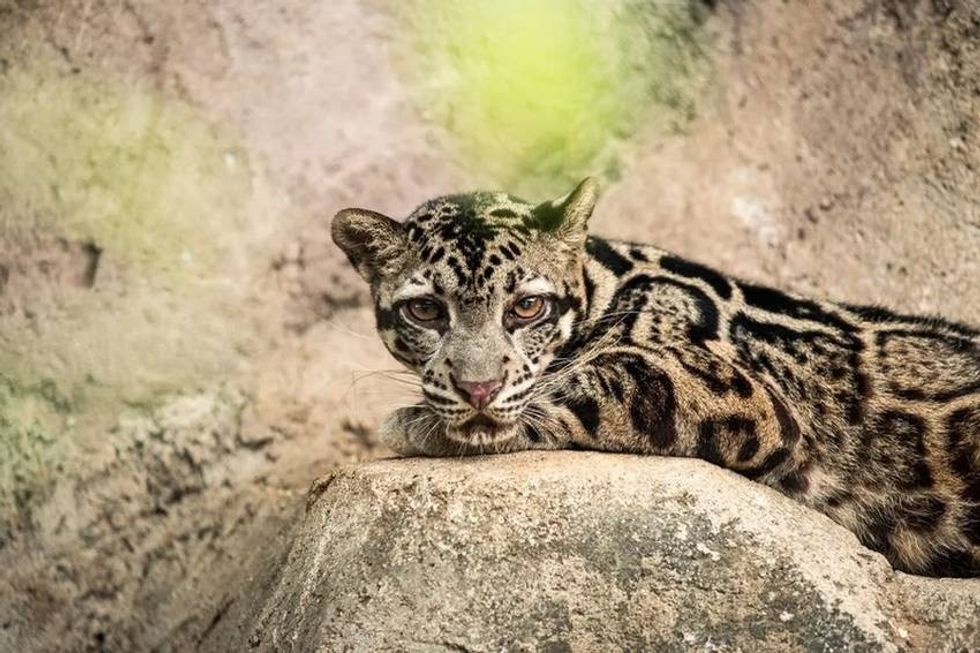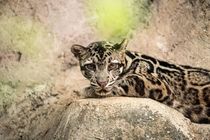The Sunda clouded leopard (Neofelis diardi) is also known as the Sundaland clouded leopard, the Indonesian clouded leopard, the Enkuli clouded leopard, the Diard's clouded leopard, and the Diard's cat. It is a species native to the islands of Borneo and Sumatra in Asia.
They are renowned for their tree-climbing skills and they will rarely come to the ground. These cats have yellowish-gray coats and big cloud markings on their bodies.
Their tail is very long and helps to maintain their body balance when jumping from the canopies. Sunda clouded leopard teeth are much longer than other living cats and they have a narrow head with a broad muzzle.
The main Sunda clouded leopard is a sister species to the mainland islands clouded leopard (Neofelis nebulosa) and is divided into two distinct subspecies.
Neofelis diardi borneensis is only found in Borneo while Neofelis diardi diardi is exclusively found on the Sumatra Islands. According to the IUCN Red List, the Sunda clouded leopard is listed as a Vulnerable species.
This is because their forest range is being cut down to make more space for oil palm plantations as Malaysia and Indonesia are the largest palm oil producers in the world.
If you liked learning about Sunda clouded leopards, you can also read about our articles on clouded leopard and snow leopard facts too!
Sunda Clouded Leopard Interesting Facts
What type of animal is a Sunda clouded leopard?
The Sunda clouded leopard, also known as a Sundaland clouded leopard, is a wild cat species most commonly found in Borneo and Sumatra, Asia. They are distinctly different from the mainland islands species (Neofelis nebulosa) or the clouded leopard.
The Sunda clouded leopard is divided into two subspecies which are the Neofelis diardi borneensis from Borneo and the Neofelis diardi diardi from Sumatra.
What class of animal does a Sunda clouded leopard belong to?
A Sundaland clouded leopard (Neofelis diardi) belongs to the class of mammals from the Neofelis genus of the Felidae family.
How many Sunda clouded leopards are there in the world?
The population size of Sundaland clouded leopards is no more than 10,000 in the world. They are listed as Vulnerable by the IUCN Red List and are often hunted for their coat or body parts.
Where does a Sunda clouded leopard live?
Southeast Asia and southern China are the home for the mainland species of clouded leopards. The locations of Sunda clouded leopards are the forests of Borneo and Sumatra in southeast Asia.
They also could be living on the island of Java and Batu, but this is not confirmed. They usually live in the lowland rainforest of Borneo and hilly or mountainous areas of Sumatra.
What is a Sunda clouded leopard's habitat?
Sunda clouded leopards (Neofelis diardi) primarily live in dense forests but are also found in other habitats such as hilly areas and low rainforests. Sometimes, this species can be found living near human settlements due to rapid habitat loss.
They are more common six times more common in Borneo than in Sumatra and they like trees overhanging cliffs. They do not descend to the ground very often and are seen commuting on top of tree canopies.
Who do Sunda clouded leopards live with?
The Sunda clouded leopard (Neofelis diardi) is generally a solitary animal and moves during the night. These cats are only seen together during the breeding season.
How long does a Sunda clouded leopard live?
The average lifespan of a Sunda clouded leopard (Neofelis diardi) species can range from 11 to 17 years.
How do they reproduce?
There is not much information available about the mating habits of the Sunda clouded leopard. In captivity, breeding behavior is impossible to observe as aggression between mates usually ends with the death of the female.
These cats may have successful breeding if introduced at a young age. There is no particular breeding season but peaks have been noticed in December and March.
The gestation period of this species usually lasts 85 to 95 days after which, the female will give birth to a litter of one to five cubs.
Cubs become independent at 10 months of age and reach sexual maturity at two years of age. Females take care of the cubs while the male Sunda clouded leopard will hunt for food.
What is their conservation status?
Sunda clouded leopards (Neofelis diardi) are listed as Vulnerable by the IUCN Red List and only have a population of 10,000 left. The main threat to their population is rapid deforestation to create more agricultural land or oil palm plantations.
Since this species tends to stay atop trees, deforestation means a major loss of habitat for both them and their prey.
Forest fires are also another major reason for their dwindling numbers. Sunda clouded leopards are also victims of excessive hunting for their coats and body parts which are used in traditional medicine.
Sunda Clouded Leopard Fun Facts
What do Sunda clouded leopards look like?
A Sunda clouded leopard (Neofelis diardi) is a medium-sized wild cat and its coat color has a yellowish-gray hue. This cat has spots, or cloud markings, which are darker than the mainland species (Neofelis nebulosa).
The spots on the coat have black outlines and two black bars on the back of the neck. The tail of this cat is very long with black rings along the length.
The head is narrow with a broad muzzle and the eyes are grayish-green. The tail length is about 24-36 in (61-91 cm) which is about 76 to 88% of body length.
Sunda clouded leopards have long canine teeth, proportionate to the skull length, which can be about 2 in (5 cm) in length and are much longer than any other living cat. Their legs are short with broad paws and flexible ankle joints, allowing them to jump between trees or climb canopies.

How cute are they?
Sunda clouded leopards (Neofelis diardi) are very talented cats that can climb vertical trees and hang on to them with their hind paws bent on tree branches. While they can be a little dangerous, they look very cute with their huge clouded markings!
How do they communicate?
The Sunda clouded leopard (Neofelis diardi) is a highly solitary species and is only seen with other leopard cats when it is the breeding season. They are known to mark their territories using scent glands. This cat can also communicate using vocal cues and body language.
How big is a Sunda clouded leopard?
The average Sunda clouded leopard size can range from 45-79 in (115-201 cm). Their tail will range from 24-36 in (61-91 cm) and their teeth are 2 in (5 cm).
How fast can a Sunda-clouded leopard run?
The average speed of Sunda clouded leopards is 40 mph (64 kph).
How much does a Sunda clouded leopard weigh?
The average weight of Sunda clouded leopards can range from 33-66 lb (15-30 kg).
What are the male and female names of the species?
A male Sunda clouded leopard (Neofelis diardi) is known as a leopard and a female Sunda clouded leopard is known as a leopardess. A group of clouded leopards is known as leaps or lepe.
What would you call a baby Sunda clouded leopard?
Baby Sunda clouded leopards are called Sunda clouded leopard cubs.
What do they eat?
A Sunda clouded leopard diet includes various forest animals including sambar deer, birds, gray leaf monkeys, wild bearded pigs, and squirrels. This cat may also attack porcupines and young proboscis monkeys.
They are stealthy and ambush their prey from the top of canopies. Not many animals prey on Sunda clouded leopards but they may be attacked by tigers. They are mainly hunted by humans for their coats and flesh.
Are they dangerous?
Sunda-clouded leopards (Neofelis diardi) do not usually attack humans but can be dangerous if agitated. There have been no records of any attacks until now. These clouded leopards may attack domestic livestock of close villages near the forests of Borneo and Sumatra.
Would they make a good pet?
Sunda-clouded leopards do not make good pets because they are wild animals that only reside in the forest. Besides, it might not be an easy task to domesticate a wild cat. They are also a vulnerable species and can only be taken in by established sanctuaries.
Did you know...
In Indonesia, Sunda clouded leopards are named 'rimau-dahan' which means 'tree tiger' or 'branch tiger'. They are also called 'entulu' in Malaysia.
How many teeth do clouded leopards have?
Like most leopards, Sunda clouded leopards have 32 teeth, two of which are large and pointed.
What is the difference between a leopard and a clouded leopard?
They were declared a different branch after a detailed examination of the Sunda clouded leopard vs the clouded leopard of the mainland was conducted. The kinship between these two species is similar to the difference between a jaguar (Panthera onca) and a leopard (Panthera pardus).
Here at Kidadl, we have carefully created lots of interesting family-friendly animal facts for everyone to discover! Learn more about some other mammals including the Javan leopard and Arabian leopard.
You can even occupy yourself at home by drawing one on our Sunda-clouded leopard coloring pages.









